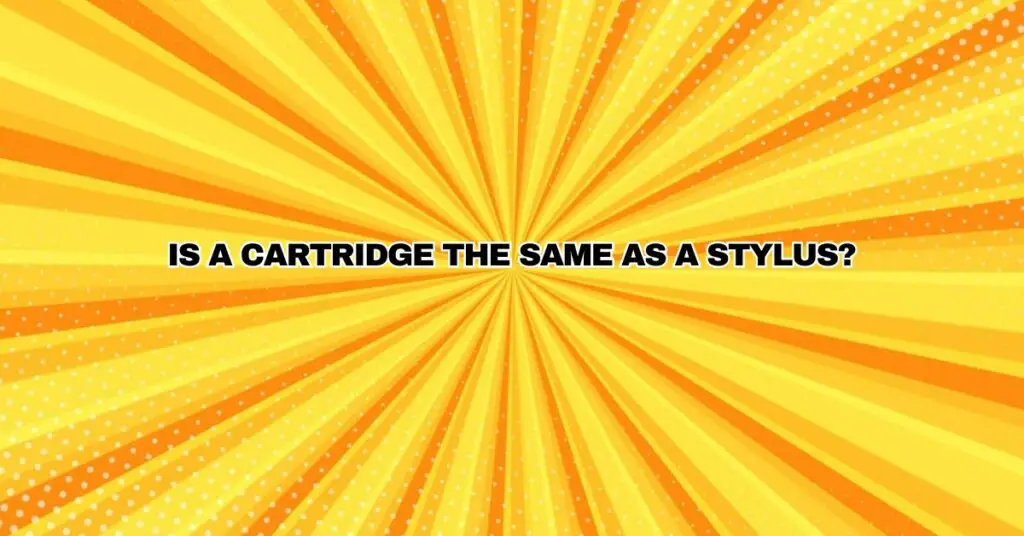A cartridge and a stylus are two distinct but closely related components in a turntable’s playback system. While they work together to create the music you hear from your vinyl records, they serve different functions and have separate roles. In this comprehensive article, we’ll explore the differences between cartridges and styli, their functions, and why both are crucial for playing vinyl records.
1. Cartridge:
Function: The cartridge is a cartridge-shaped housing that holds several important components, including the stylus (needle) and the generator. The generator, in turn, contains a magnet or coil, which interacts with the stylus to convert mechanical vibrations from the stylus into electrical signals.
Key Components:
- Stylus Mount: This is where the stylus is attached or mounted to the cartridge.
- Generator: The generator is the heart of the cartridge. It converts the stylus’s mechanical movements into electrical signals.
- Body: The cartridge’s body is typically made of plastic or metal and provides structural support and protection to the internal components.
- Terminals: These are the electrical connections on the cartridge that connect to the tonearm’s wiring.
Varieties: Cartridges come in two primary types: moving magnet (MM) and moving coil (MC). These types differ in how the generator operates and generate electrical signals.
2. Stylus (Needle):
Function: The stylus, often referred to as the needle, is a tiny, pointed component that physically makes contact with the grooves of a vinyl record. It follows the grooves’ modulations and vibrates in response to the varying depths and shapes of the grooves.
Key Components:
- Tip: The tip of the stylus is the part that touches the vinyl grooves. It’s usually made of a hard material like diamond or sapphire, ensuring minimal wear over time.
- Cantilever: The cantilever is a small rod-like structure that connects the stylus tip to the cartridge. It transfers the stylus’s vibrations to the cartridge’s generator.
Types: Stylus tips come in different shapes, including conical, elliptical, and shibata, each with varying characteristics that impact tracking accuracy and audio quality.
Differences Between Cartridges and Styli:
1. Function:
- Cartridge: The cartridge houses the stylus and serves as the component responsible for generating electrical signals from the stylus’s movements. It is the interface between the stylus and the tonearm, ultimately connecting the mechanical vibrations from the stylus to the electrical components of the turntable.
- Stylus: The stylus is the part that physically touches the vinyl record grooves. It reads the analog information encoded in the grooves by vibrating in response to the groove’s modulations. These vibrations are then transferred to the cartridge, which translates them into electrical signals.
2. Replaceability:
- Cartridge: While cartridges can be replaced, they tend to be a more significant investment than styli. Cartridge replacement is typically done to change the overall sound characteristics or when the cartridge itself is damaged or worn.
- Stylus: Stylus replacement is common and is typically needed after prolonged use or when the stylus becomes worn, damaged, or broken. Replacing the stylus is a cost-effective way to maintain or upgrade the performance of a cartridge.
3. Compatibility:
- Cartridge: Cartridges come in various designs, mounting styles, and electrical outputs. It’s crucial to select a cartridge that is compatible with your turntable’s tonearm and wiring.
- Stylus: Replacement styli must be compatible with the specific cartridge model. It’s essential to choose a stylus that matches the cartridge’s specifications and mount type.
4. Cost:
- Cartridge: Cartridges tend to be more expensive than styli. Replacing a cartridge can be a significant investment, often resulting in a change in sound characteristics.
- Stylus: Stylus replacement is more budget-friendly and is a practical solution when the cartridge is in good condition, but the stylus itself is worn or damaged.
In conclusion, while a cartridge and a stylus work together to play vinyl records, they serve distinct roles in the playback process. The cartridge is responsible for converting the stylus’s mechanical vibrations into electrical signals, while the stylus physically follows the grooves on the record. Understanding the differences between these components is essential for maintaining and optimizing your vinyl listening experience, whether you’re considering replacement or upgrading your turntable setup.


